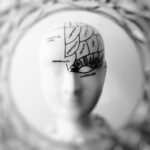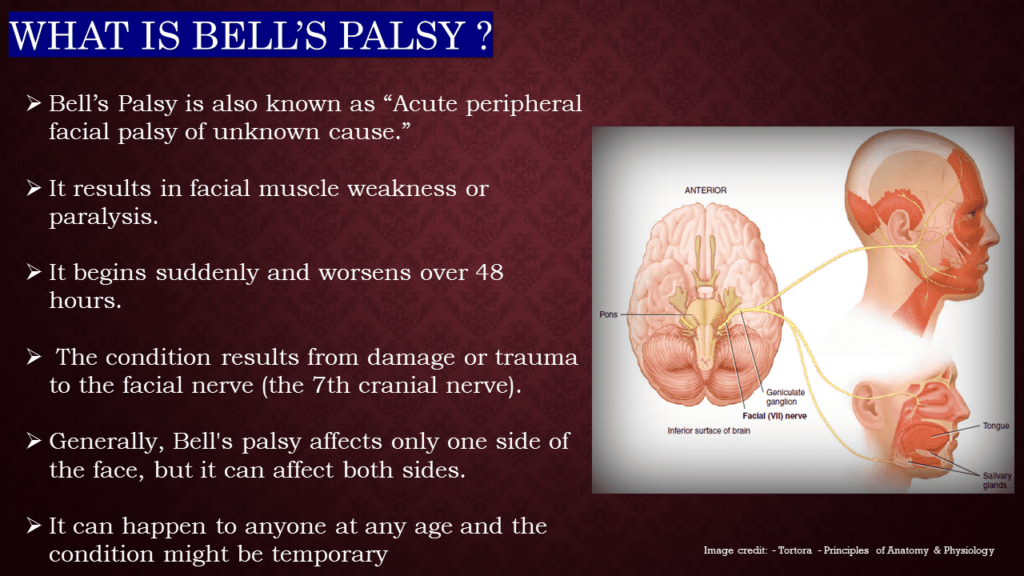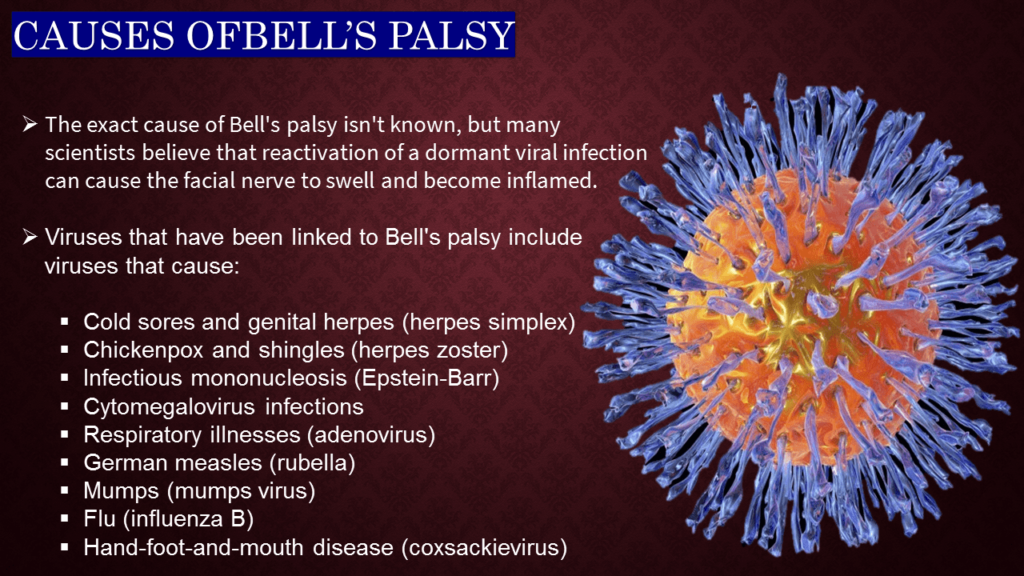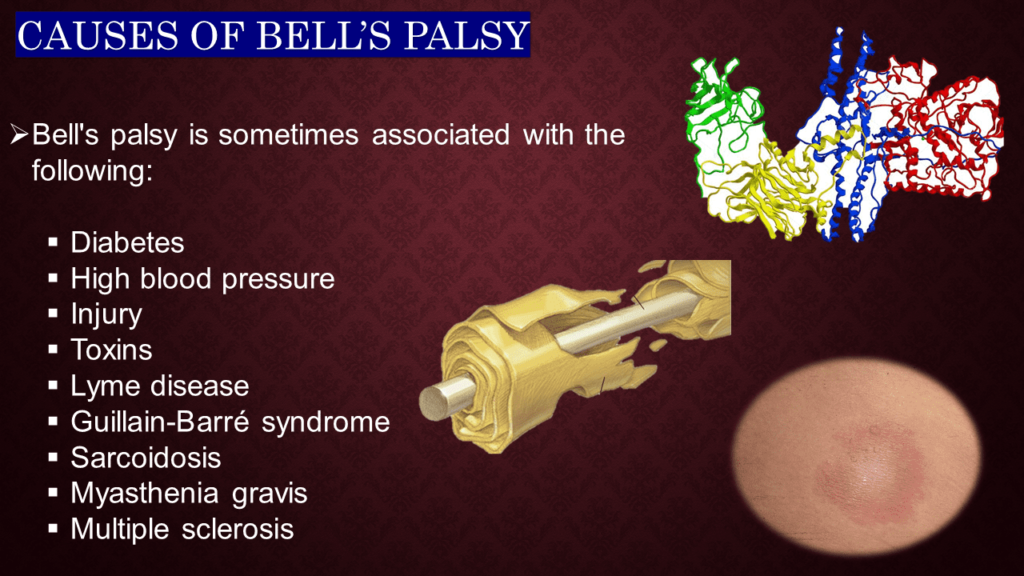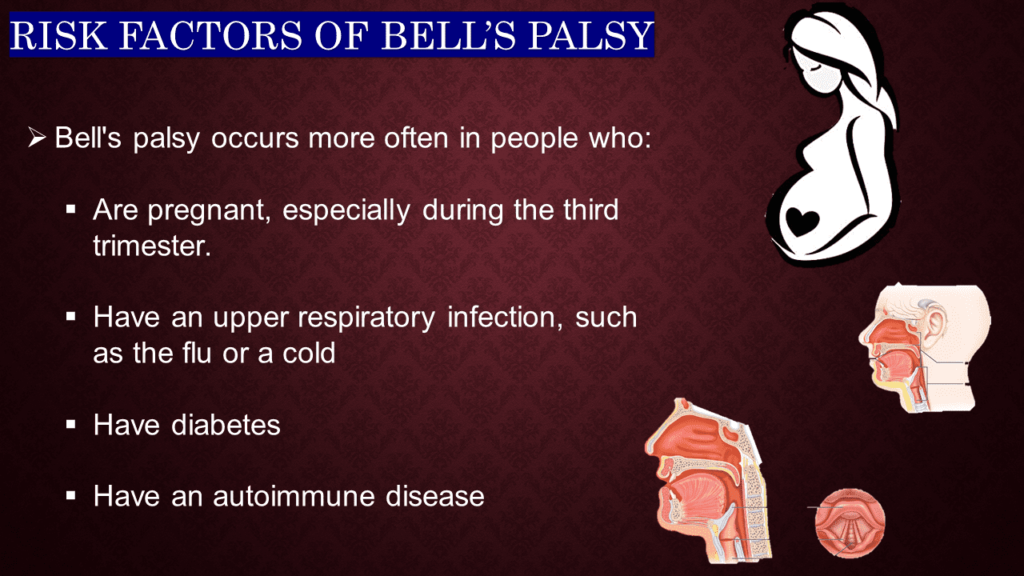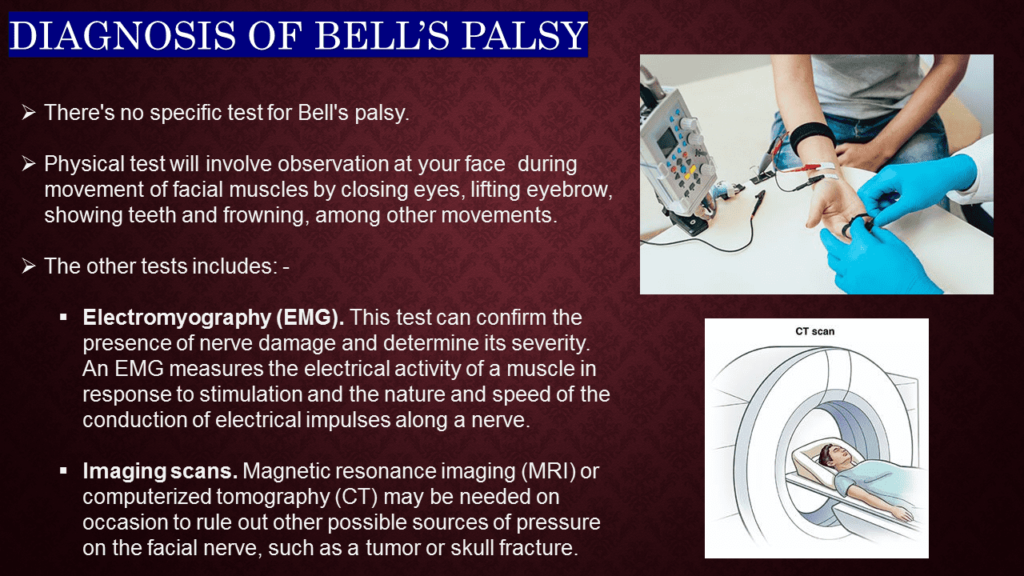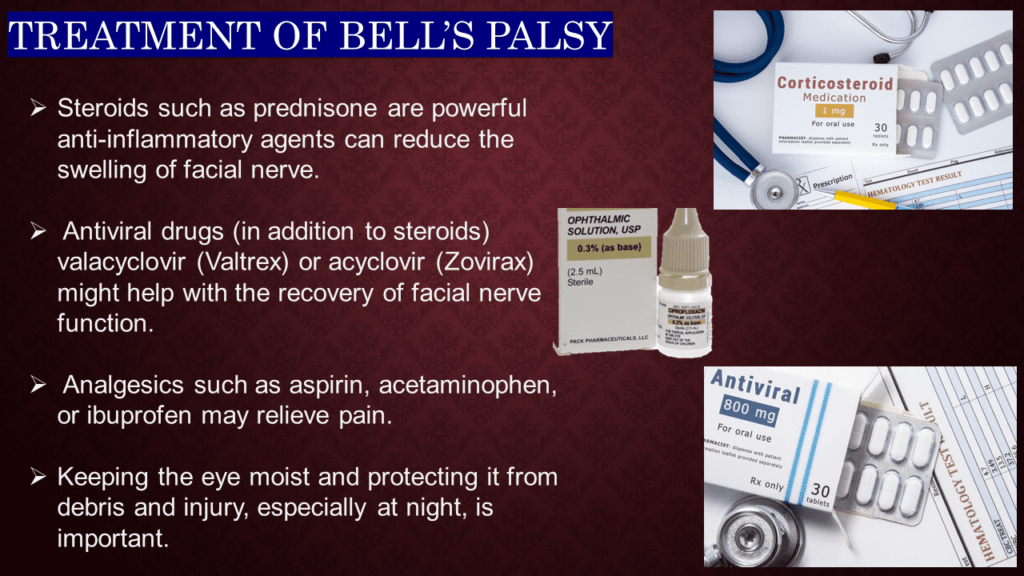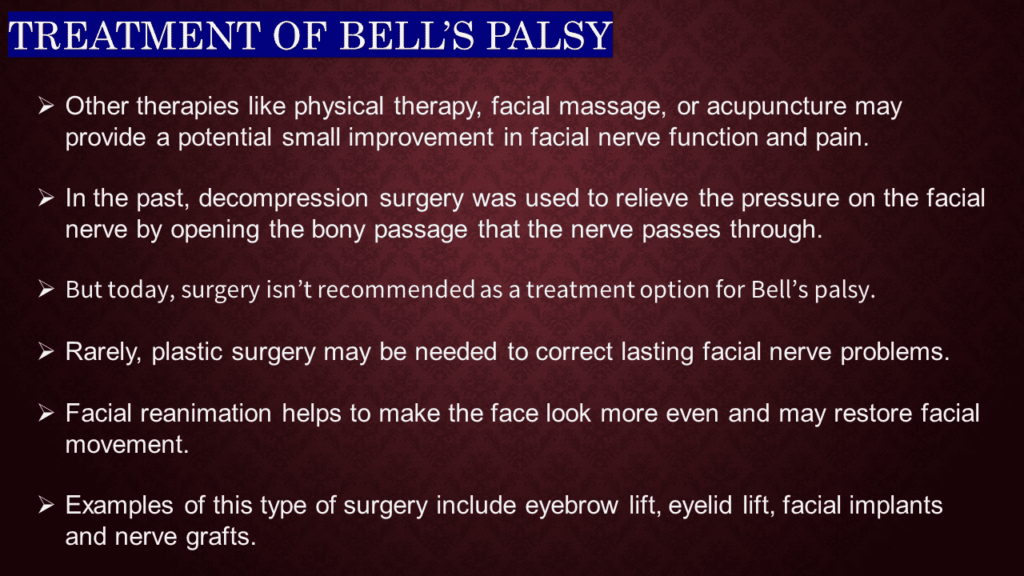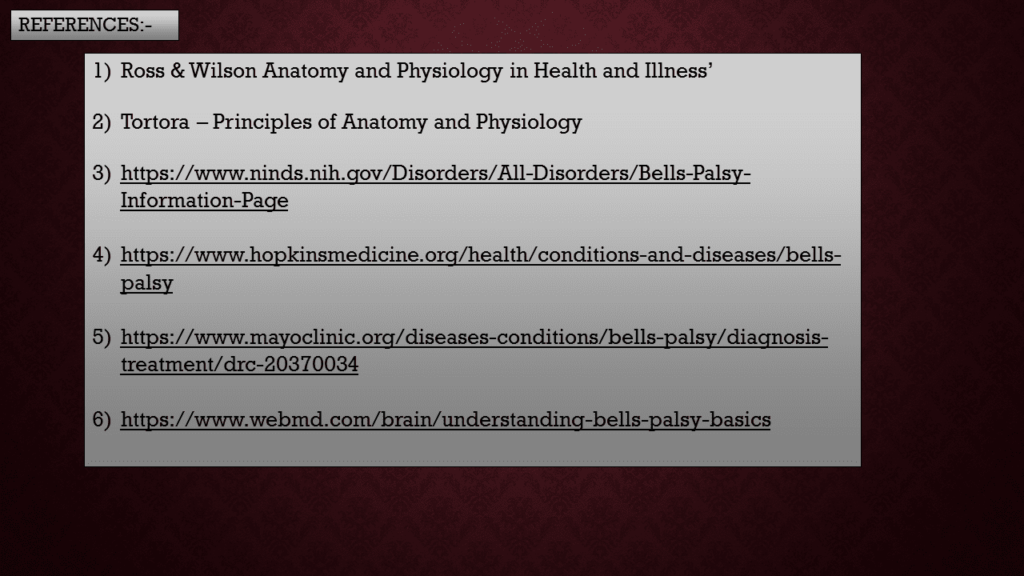Bell’s Palsy causes due to damage to the 7th cranial nerve, also called the facial nerve. It is also known as “Acute peripheral facial palsy” It results in weakness or paralysis of facial muscles. The condition primarily affects one side of the face; sometimes, it can affect both sides. It can happen to anyone at any age, and the state might be temporary.
Table of Contents
What Causes Bell’s Palsy?
The exact cause of Bell’s Palsy is unknown. Studies suggest that reactivation of a dormant viral infection can cause the facial nerve to swell and become inflamed.
There are several viruses linked to Bell’s Palsy, like
- Cold sores and genital herpes (herpes simplex)
- Chickenpox and shingles (herpes zoster)
- Infectious mononucleosis (Epstein-Barr)
- Cytomegalovirus infections
- Respiratory illnesses (adenovirus)
- German measles (rubella)
- Mumps (mumps virus)
- Flu (influenza B)
- Hand-foot-and-mouth disease (coxsackievirus)
What are the Risk Factors?
- Pregnancy
- Respiratory Infection
- Autoimmune disease
- Lyme disease
- Guillain-Barré syndrome
- Sarcoidosis
- Diabetes
- Myasthenia gravis
- Multiple sclerosis
Signs and symptoms of Bell’s Palsy
- Facial droop.
- Drooling
- Mild weakness to total facial paralysis on one side.
- Pain around the jaw.
- A loss of taste.
- Pain in or behind the ear.
- Headache.
- Increased sensitivity to sound.
- Change in the amount of tears and saliva.
What are the Complications?
Mild cases of Bell’s Palsy usually disappears, but the severe cases involve various complications like: –
- Irreversible facial nerve damage.
- Abnormal regrowth of nerve fibers.
- Partial or complete blindness.
Diagnosis: How to diagnose it?
- Medical history – Check for symptoms and other risk factors.
- Physical examination – Observation of the face during movement of facial muscles by closing eyes, raising eyebrows, showing teeth, and frowning.
- Diagnostic tests – The tests performed are:
- Electromyography (EMG) determines the extent of the nerve involvement.
- Magnetic resonance imaging (MRI) helps to analyze the structural cause of the symptoms.
- Computerized Tomography (CT) Scan
Treatment: How is Bell’s Palsy treated?
Medications :
- Steroids- can increase the probability of good facial functional recovery if started within 72 hours of symptom onset.
- Antiviral drugs- like acyclovir.
- Analgesics- aspirin, acetaminophen, or ibuprofen.
- Eye drops for lubricating dry eyes- artificial tears, eye ointments or gels, and eye patches.
Therapy :
- Physical Therapy to stimulate the facial nerve.
- Facial Massage may help to regain facial strength and expression.
Surgery :
- Decompression Surgery
- Eyebrow and Eyelid lift facial reanimation
Prevention: Can we prevent it?
Prevention –
We cannot prevent Bell’s Palsy.
Living with the disorder–
Most cases of Bell’s Palsy usually resolve within time and cause no long-term complications. However, it is important to take medicines as directed by the physician.
You may need to use an eyedrop to protect the affected eye from drying. Apply an eyedrop during the day and ointment at bedtime to protect the cornea from scratching.
When to see a doctor? :
Always consult a neurologist immediately if observed any symptoms. The typical consultation fee for a neurologist ranges from ₹ 500 to ₹ 2000 in India.

Consult a Neurologist for Bell’s Palsy
- Dr. Vrajesh Udani- Neurologist in Mumbai
- Dr. Zehra Husain- Neuro Surgeon at Saifee Hospital, Mumbai
- Dr. YOGESH PATIDA- Neurologist at Bhaktivedanta Hospital, Mumbai
- DR. VISHAL KUNDNANI- Spine Surgeon in Mumbai
- Dr. Vinod Rambal- Neuro Surgeon in Mumbai
- Dr. Viswanathan Iyer- Neuro Surgeon at Hiranandani Hospital, Mumbai
- Dr. VISHWANATHAN IYER- Neuro Surgeon at Kohinoor Hospital, Mumbai
- Dr. Vivek Agrawal- Neuro and Spine Surgeon at Sir H. N. Reliance Foundation Hospital, Mumbai
- DR. VINAY S. CHAUHAN- Neurologist at Lilavati Hospital, Mumbai
Know about Neurological Disorders
- How Cerebral Hypoxia can lead to brain damage?
- Bipolar Disorder
- Mononeuropathy
- Poliomyelitis
- Neurodegenerative disorders
- Huntington’s disease (HD)
- Cerebral edema
- Migraine
- Brain Hemorrhage
- Epilepsy
- Polyneuropathy
- Encephalitis
- Increased Intracranial Pressure
- Types of Brain Tumors You Should Know About
- Brain Stroke: Symptoms, Diagnosis and Treatment
- Amyotrophic Lateral Sclerosis: Symptoms and Diagnosis
- Brain aneurysms: Symptoms and Diagnosis
- Attention Deficit Hyperactivity Disorder (ADHD): What You Need to Know
- Peripheral Neuropathy
- Understanding Carpal Tunnel Syndrome: A Guide for Patients















